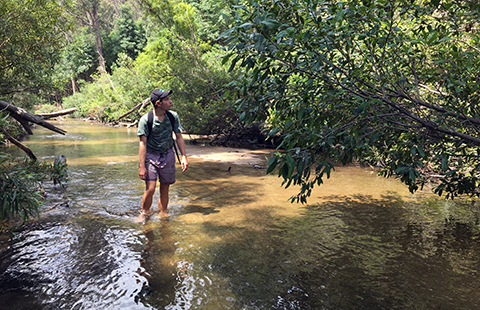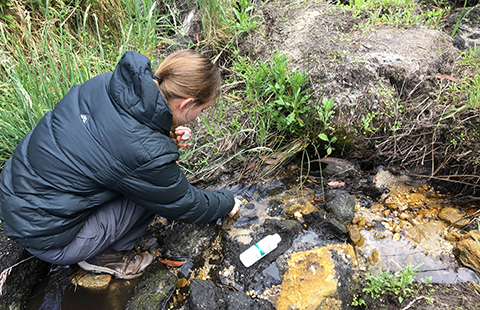
Western Sydney University researcher Callum Fleming in the Wollangambe River
Western Sydney University researchers studying the impact of wastewater on the Wollangambe River – a body of water that flows through the heart of the Blue Mountains World Heritage area – have documented a ‘river in recovery’.
As part of a new research report, ‘Legacy Contamination of River Sediments from Four Decades of Coal Mine Effluent Inhibits Ecological Recovery of a Polluted World Heritage Area River’ , the research team has recorded a stunning turnaround of the high conservation-value river.
According to lead author Dr Ian Wright from the School of Science, a revised environmental licence that authorises the disposal of coalmine effluent has reduced the severity and extent of water pollution and associated ecological damage of the river.
“We know a series of water quality and ecological impacts have been reported in rivers and streams affected by active and closed coal mines in the Blue Mountains region of the Sydney Basin’s western coalfields,” said Dr Wright.
“This was the case with the Wollangambe River, where we first investigated water quality and river invertebrate health in 2014, to find a high level of pollutants present, such as zinc and nickel.”
Dr Wright said a revised environmental license issued in 2020 by the Environment Protection Agency has significantly reduced the impact of pollutants on the river.
“Our latest study found the improvement in water quality and ecological health is most apparent 22 kms downstream of the mine discharge, when comparing results from the current 2020 study with an earlier study in 2012/2013.”
“The findings highlight the importance of appropriate and site-specific environmental licencing to protect riverine ecosystems of conservation significance from long-term contamination.”
Dr Wright believes the recovery is a testament to the Blue Mountains community, who petitioned for stronger licensing of waste disposal into the river.
The river is now the focus of a recently launched documentary by environmental filmmaker James O’Connor titled ‘Mining the Blue Mountain’s .
Holly Nettle, who studies the Bachelor of Science (Environmental Science), is among the researchers, alumni and students of the University that contributed to the film.
“I got involved in the documentary because I wanted to help raise awareness about the negative impacts of mining not just on the environment, but also on human health,” said Holly.

Western Sydney University student Holly Nettle taking water samples from a creek located in the Blue Mountains World Heritage Area
Holly said that river health is very important to her because rivers are the lifeblood of landscapes not just in Australia but also around the world.
“The Greater Blue Mountains World Heritage Area is unique, it contains plant and animal species found nowhere else but it is also home to some of the most pristine watercourses in Australia.”
“These ecosystems are fragile and if we damage them, they do not always recover. We must also respect the importance and sacredness of rivers to Aboriginal and Torres Strait Islander Peoples.”
Dr Wright added: “This current research reveals that two decades after the Greater Blue Mountains was listed by UNESCO as a natural World Heritage site, progressive tightening and more effective environmental regulations are reducing the severity of coal mine pollution in the Wollangambe River.”






